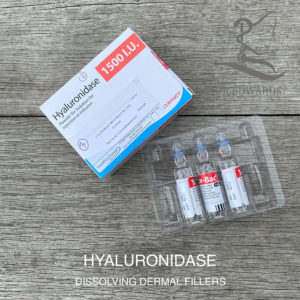Dermal filler treatments to the face and lips have become much more popular in the last few years. Changes in fashion, ease of access and greater awareness about non-surgical aesthetic possibilities have all contributed to the rise of hyaluronic acid dermal fillers as a treatment of choice for many aesthetic patients. But what happens if the results of treatment just don’t work for you, can anything be done to help the situation? Well, actually there is a way of dealing with unsightly filler!
Hyaluronidase (usually found as Hyalase®) is an enzyme which breaks down the bonds that hold the hyaluronic acid molecules together in dermal filler. Once these bonds are broken down the filler is dispersed by the body naturally.
If you have had treatment which has given an unsatisfactory result, for example asymmetry, nodules, lumpiness, puffiness or just an unwanted overfilled look, the first step is to see a suitably qualified professional to get an assessment of the problem. Sometimes there are other approaches such as massaging or re-sculpting the filler which are more appropriate.
If it is decided that hyaluronidase is the best treatment option, a small test injection will be performed on the forearm as some people can have an allergic reaction. A small test patch must be used prior to a first treatment. If this is satisfactory after 20 to 40 minutes then the hyaluronidase can be injected directly into the desired area. The first results can sometimes be seen quite quickly but it can take up to 2 weeks to see the full effects. It is not unusual to need more than one treatment.
Hyaluronidase isn’t perfect. The enzyme may remove more filler than desired. This may require another filler treatment to achieve your original goals, in fact often the practitioner will aim to remove as much filler as possible so as to provide a clear field for a new approach. The procedure is not pain free and can be more uncomfortable than the original filler application. Afterwards there can be swelling, bruising and redness. It is only suitable to use for reversal of hyaluronic acid fillers and will not help in the same way with products such as Ellanse® or Sculptra® which are made of different compounds.
Hyaluronidase is a prescription-only medication and its use in filler dispersal is an off-license procedure so you need to be sure that your practitioner is suitably qualified to prescribe it, has experience of the correct protocols1 when injecting it and can deal with any (rare) reactions safely.
Perhaps most important of all is that any practitioner using dermal filler should be confident in using hyaluronidase and always have immediate access to it in their clinic. Why? Because this product is also used in serious emergency filler complications where time is of the essence. This use will be covered in the next hyaluronidase blog.
References:
- Dr Martyn King, Dr Cormac Convery, Emma Davies, Aesthetic Complications Expert Group, The Use of Hyaluronidase in Aesthetic Practice.

